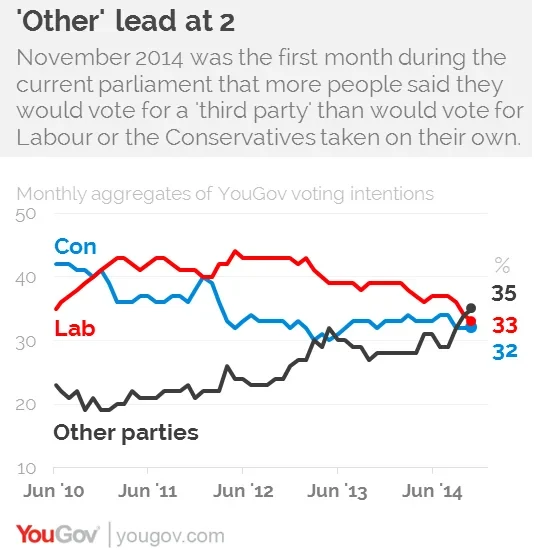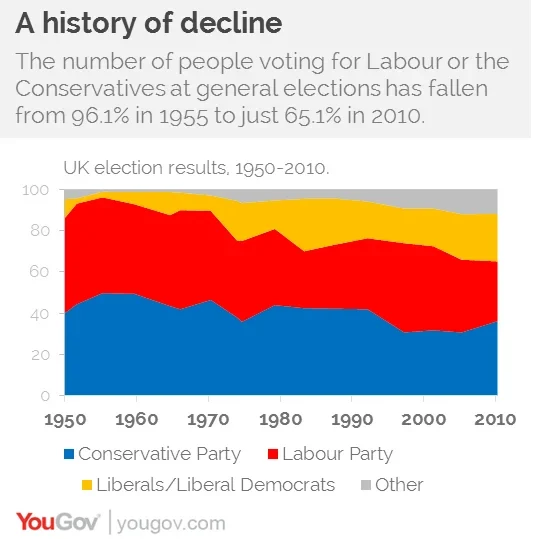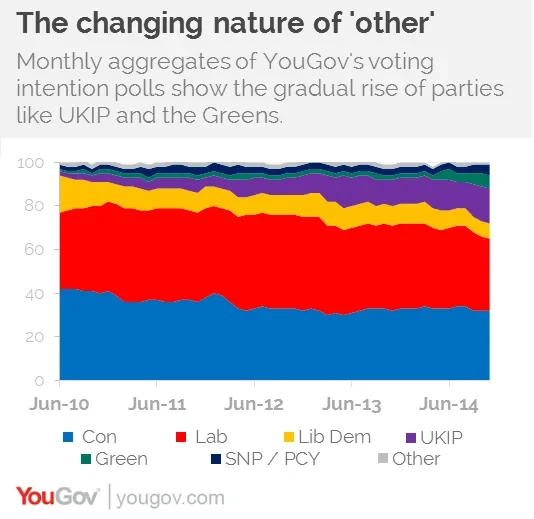Labour and the Conservatives are taking up a shrinking share of voting intentions, and for the first time since 2010 they are each outpolled by the other parties put together
This November marks the first month of the current parliament when more voters would vote for some other party than pick either the Conservative or Labour party on their own – and several of those other parties have reached new heights.
Most voters – just under two-thirds (65%) of them – intend to vote either Labour or Conservative. However, in an aggregation of all of YouGov’s November voting intention polls, 33% of voters said they would pull the lever for Labour and 32% said they would go for the Conservatives (Labour’s smallest lead since February 2012). That leaves 35% who would vote for some other party, the first time ‘other’ has led the two main parties in a monthly aggregation since June 2010.

Notably, if things were to pan out this way at the general election next May, it would not be the first time the two biggest, oldest parties took less than two-thirds of the vote. In both 2005 and 2010, this happened, following a decades of decline from 1955, when 96.1% of votes were cast for one of the two main parties. However, even in the last two elections, at least one of the parties (Labour in 2005, and the Conservatives in 2010), had more votes than the other main party or the remaining votes counted as a bloc.
What’s different now, is that the historical third main party, the Liberal Democrats (or its predecessor, the Liberals), has almost always taken the vast majority of the “other” votes. Even in 2010, when Con-Lab took their smallest share of the vote (65.1%) in nearly a century, Lab-Con-Lib Dem took 88.1% of all votes. As of this November, the three main parties are taking only 72% of the vote (the Lib Dems were on 7% last month, a tie with October and September for their lowest during this parliament).

New kids on the block
Meanwhile, three of the remaining parties have some of their best monthly figures since at least June 2010. UKIP tie their all-time high of 16%, first achieved in October. The same is true of the Green party, who match the previous month's high-water mark of 6%. The Scottish and Welsh nationalist parties, who are counted together, have reached 5% for the first time in this parliament.
This shows tremendous growth from where the parties stood in June 2010, when 94% of voters said they would vote Con-Lab-Lib Dem. Then, UKIP were getting between 1 and 3% and SNP/Plaid Cymru were getting 1-2% combined, same as the Greens.

Of course, caveats apply. Many voters may “go home” to the main parties, as tactical thinking takes over. However, the latest polling data suggests 2015 will not reverse the pattern of decline faced by the two main parties over the past half-century – and the Lib Dems, who have traditionally picked up most of the slack, may no longer be immune.
See YouGov's voting intention data








